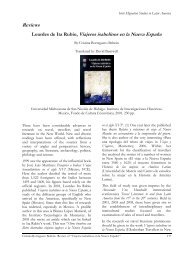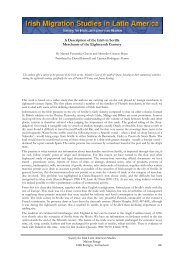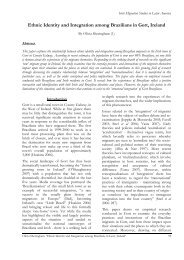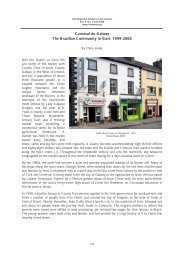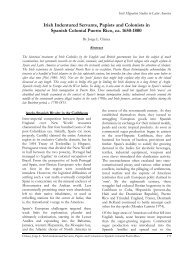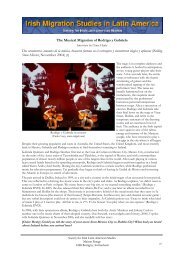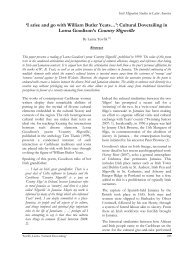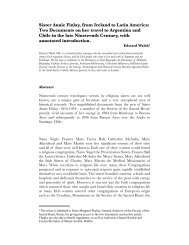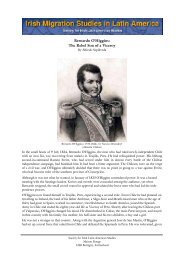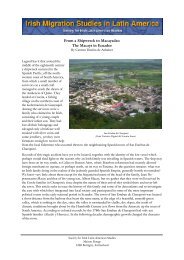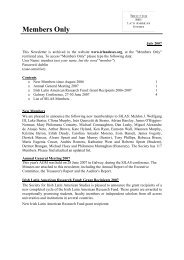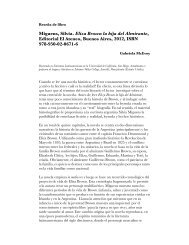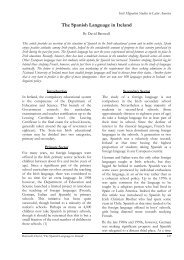I:6 Anti-dumping - Society for Irish Latin American Studies
I:6 Anti-dumping - Society for Irish Latin American Studies
I:6 Anti-dumping - Society for Irish Latin American Studies
Create successful ePaper yourself
Turn your PDF publications into a flip-book with our unique Google optimized e-Paper software.
The school was christened Saint Ciaran’s, in honour of the <strong>Irish</strong> patron saint of students, who founded<br />
Clonmacnoise abbey -renowned centre of learning- in the sixth century. Classes commenced on March 1,<br />
1933 with the presence of 6 teachers and 35 pupils.<br />
Saint Ciaran’s was attended by boarders, day pupils and half-boarders. Some girls were incorporated, but<br />
were kept in separate classes. They all had access to football fields, tennis and basketball courts, a vegetable<br />
garden and a private chapel. [55]<br />
The staff was highly qualified: professor Weston came from the University of Cambridge, while professor<br />
Morris had studied at Ox<strong>for</strong>d and London. Qualified national teachers were in charge of Mathematics,<br />
Sciences and Celtic. [56] Despite being a bilingual school, where most of the students did not speak<br />
Spanish as their mother tongue, this did not imply the duplication of subjects, since Healy understood this<br />
would not be beneficial.<br />
Five years after its inauguration, Saint Ciaran’s announced its incorporation to National School Nº 8<br />
“Julio A. Roca”. The kindergarten had just been inaugurated and a sports field had been acquired. Two<br />
modern school buses provided “safe transportation from any address in the Federal Capital” [57] . The six<br />
original teachers were now fifteen. The 102 primary students who had sat <strong>for</strong> the national exams had<br />
achieved a high average.<br />
By 1943, professor Healy could announce that the spectacular increase in student matriculations -they<br />
were already 170- “was no spontaneous development, but the result of ceaseless labour, combined with<br />
scrupulous attention to all details of scholastic improvements, trusting more in progressive results and the<br />
cooperation of contented parents, than in flamboyant propaganda.” [58] .<br />
School Life<br />
Up to the 1960s, the schools of the <strong>Irish</strong>-Argentine community accepted boarders. Girls and boys came<br />
from all over the province of Buenos Aires to the Mercy, Pallotine, Passionist and other schools which we<br />
have already described. We will glimpse at their lives far from home, by taking as a model the daily routine<br />
imposed by the Sisters of Mercy in their schools, and describe the life of their students in the 1920s and<br />
30s. [59]<br />
They woke up at 6 am. After listening to mass (on Sundays and religious feasts) and taking breakfast, girls<br />
would comply with the tasks assigned by the Sisters (laundry, cleaning, cooking). The rest of the morning<br />
was dedicated to Spanish lessons. It was compulsory <strong>for</strong> all schools to comply with the official programme<br />
and <strong>for</strong> the students to sit <strong>for</strong> the exams of the National Education Council in November. Local staff was<br />
in charge of this important area in the curriculum.<br />
The afternoons were devoted to English lessons, which were in charge of the Sisters. Subjects included,<br />
besides Grammar and Literature, History (including <strong>Irish</strong> history), Geography, Biology, Maths, Religion,<br />
etc. The students sat <strong>for</strong> the exams of the local English Cultural Association and <strong>for</strong> the Cambridge exams.<br />
At 3 o’clock they would have tea, a short break and then study hours. After dinner and prayers they went<br />
off to bed, at about 8 pm.<br />
The boarders were allowed to receive visitors on Sundays and holidays. If they behaved properly, they<br />
were allowed to turn on the radio and improvise small dances. Outings were mostly related to religious<br />
occasions, such as Easter, Corpus Christi or Saint Patrick’s, which was celebrated by the pupils of the<br />
schools located in Buenos Aires at Holy Cross church along with the rest of the community. The International<br />
Eucharistical Congress of 1934 was a well-remembered event, since it involved incessant activities.<br />
In all of the <strong>Irish</strong>-Argentine schools, many hours were spent in activities that exceeded books. Following<br />
the principle of “mens sana in corpore sano” sports were widely practiced: tennis, hockey and netball by the<br />
girls, football and basketball by the boys.<br />
While the <strong>American</strong> Passionist Brothers taught their pupils to play baseball, the Pallotines relied on hurling<br />
to stress the loyalty of their pupils to Ireland, and the Christian Brothers on rugby to promote a team<br />
spirit. In keeping with the militarisation of Argentine society in the 1930s, boys started to receive drills<br />
from military officers. On a more original note, there were swimming lessons <strong>for</strong> the girls at Michael Ham<br />
which took place in the River Plate!<br />
Furthermore, well-educated girls had to have other accomplishments: they were taught to sew and<br />
embroider, French, manners, piano and singing; in some cases, they also per<strong>for</strong>med <strong>Irish</strong> dances. In the<br />
María José Roger, The Children of the Diaspora .................................................................................. 13



